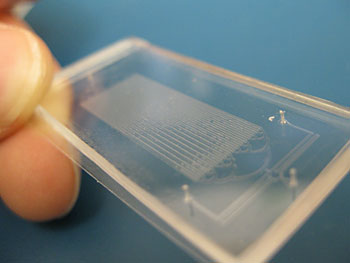Using millions of glowing bacteria to detect toxins
January 3, 2012

Tiny microfluidic chips allow the researchers to synchronize the bacteria to fluoresce or blink in unison (credit: UCSD)
UC San Diego (UCSD) scientists have created a living neon sign composed of millions of bacterial cells that periodically fluoresce in unison like blinking light bulbs — a visual display of how researchers in the new field of synthetic biology can engineer living cells like machines.
They attached a fluorescent protein to the biological clocks of the bacteria, synchronizing the clocks of the thousands of bacteria within a colony, then synchronizing thousands of the blinking bacterial colonies to glow on and off in unison.
Using the same method to create the flashing signs, the researchers engineered a simple bacterial sensor capable of detecting low levels of arsenic. In this biological sensor, decreases in the frequency of the oscillations of the cells’ blinking pattern indicate the presence and amount of the arsenic poison.
Because bacteria are sensitive to many kinds of environmental pollutants and organisms, the scientists believe this approach could be also used to design low cost bacterial biosensors capable of detecting an array of heavy metal pollutants and disease-causing organisms. And because the senor is composed of living organisms, it can respond to changes in the presence or amount of the toxins over time, unlike many chemical sensors.
“If you have a bunch of cells oscillating, the signal propagation time is too long to instantaneously synchronize 60 million other cells via quorum sensing,” said Jeff Hasty, a professor of biology and bioengineering at UC San Diego. But the scientists discovered that each of the colonies emit gases that, when shared among the thousands of other colonies within a specially designed microfluidic chip, can synchronize all of the millions of bacteria in the chip. “The colonies are synchronized via the gas signal, but the cells are synchronized via quorum sensing. The coupling is synergistic in the sense that the large, yet local, quorum communication is necessary to generate a large enough signal to drive the coupling via gas exchange,” added Hasty.
Each of the blinking bacterial colonies comprise what the researchers call a “biopixel,” an individual point of light much like the pixels on a computer monitor or television screen. The larger microfluidic chips contain about 13,000 biopixels, while the smaller chips contain about 500 pixels.
Hasty said he believes that within five years, a small hand-held sensor could be developed that would take readings of the oscillations from the bacteria on disposable microfluidic chips to determine the presence and concentrations of various toxic substances and disease-causing organisms in the field.
Ref.: Arthur Prindle et al., A sensing array of radically coupled genetic “biopixels,” Nature, 2011 [doi: 10.1038/nature10722]